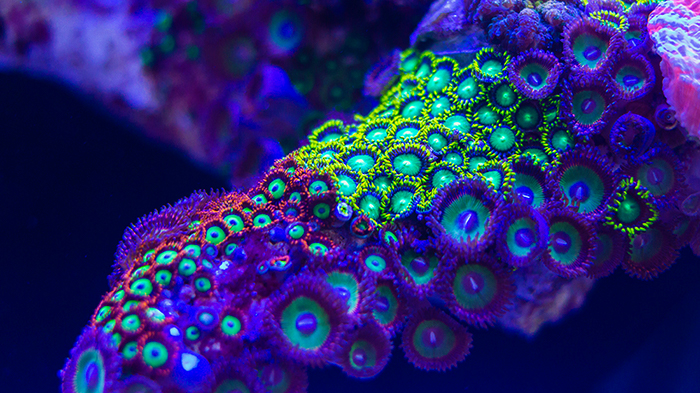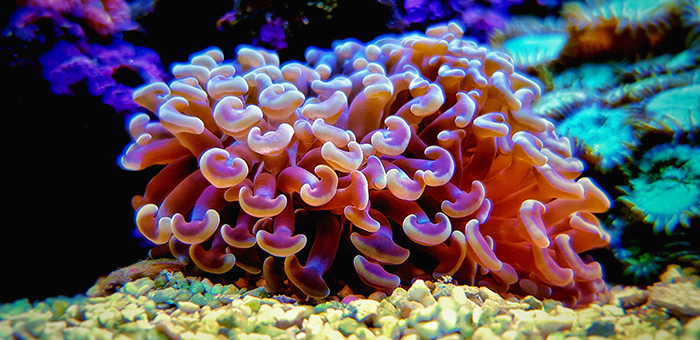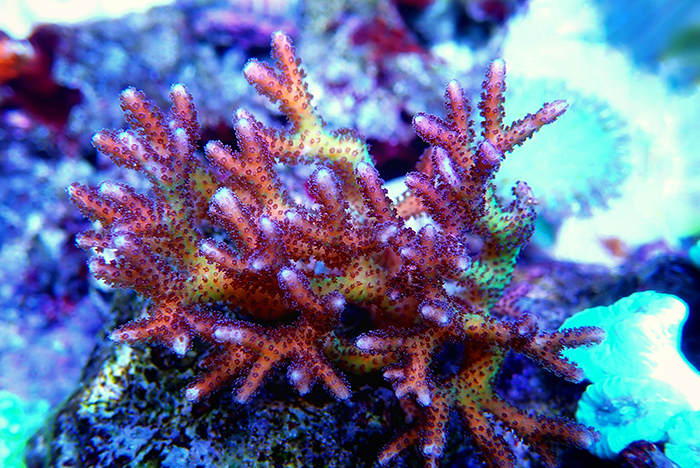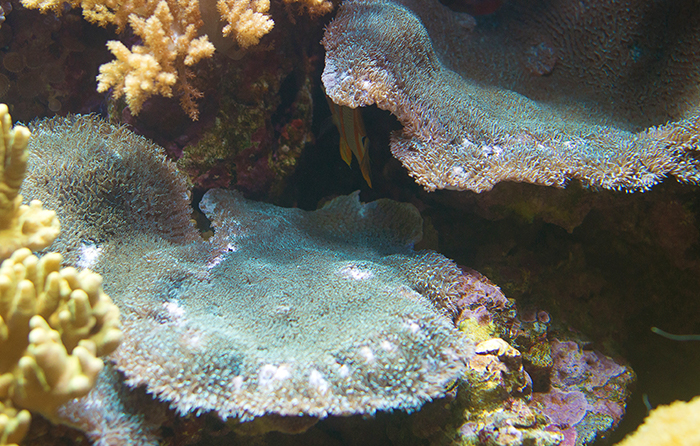If you dream of having your own reef tank, you are not alone. Reef tanks are visually stunning and wildly popular! These miniature landscapes are often what come to mind when it comes to saltwater aquariums. However, getting started with a reef tank is no simple feat!
There are over 6,000 varieties of coral that exist on a spectrum of needs. Some are more sensitive to light and water chemistry than others. For those just diving into coral keeping, it is best to begin with varieties that are more forgiving and gradually work your way up to more temperamental types.
In this Saltwater Coral Guide, we are breaking down 20 species of coral to keep in your tank, ranked from least difficult to most advanced. Once you settle on the environment you desire, remember to select complimentary fish. See: Best Saltwater Aquarium Fish for Beginners.
Table of Contents
Mushroom
Quick Info:
- One of the easiest corals to keep
- Recommended for: Beginners
- Color: Red, green, purple, blue, gray
- Growth Speed: Fast
- Compatibility: Mostly peaceful
Mushroom Corals (also called Mushroom Anemones, Disc Anemones, or simply “Mushrooms”) are among the best coral for beginners. They are hardy, reproduce quickly, and encompass a wide range of species of various colors, sizes, patterns, and textures. They have low lighting requirements and do best in low-to-moderate water movement. Mushroom coral under low lighting will stretch upwards toward the light, whereas under too-bright light they tend to shrivel; mushrooms receiving the perfect amount of light lie flat. They are photosynthetic and will also absorb nutrients from the water, and therefore do not need to be manually fed in a healthy tank.
In short, mushroom are ideal “starter coral” but don’t let the ease of their care fool! These are not exclusive to beginners. Mushroom are one of the most collected species of corals for advanced hobbyists due to their amazing color combinations and their different variants of growth shapes.
Green Star Polyps
Quick Info:
- This coral grows quickly and can fill up a barren tank in no time!
- Recommended for: Beginners
- Color: Green
- Growth Speed: Very fast
- Compatibility: Peaceful (but may grow over other coral)
Green Star Polyps (commonly referred to as GSP) are soft coral that are some of the most popular saltwater corals for beginners. Not only can it thrive in virtually any combination of lighting, water flow, and placement, but it also adds movement to the tank with its polyps that hypnotically sway to the flow of the tank. It also grows extremely quickly – perhaps even too rapidly! Left unchecked, it will grow on rocks, the sides of the tank, even over other coral! Keep its rapid expansion in mind when placing it in your tank. While they do gather energy through light, they will benefit from occasional spot feeding, especially if you are looking to jumpstart its growth.
Pulsing Xenia
Quick Info:
- Pulsing Xenia is an excellent source of movement for your tank.
- Recommended For: Beginners
- Color: Gray, tan, white, pink
- Growth Speed: Very fast
- Compatibility: Peaceful (but may grow over other coral)
Pulsing Xenia have many things in common with GSPs. While they are slightly more sensitive to tank conditions, they are still extremely hardy and a good choice for new tanks. They also have the potential to grow out of control if permitted, so watch out! However, if placed on an island or next to some more aggressive coral that will keep them in line, pulsing xenia can be a beautiful addition to your tank. What sets it apart from other coral is the pulsing for which it is named. The pulsing xenia’s polyps open and close in a pulsing motion that make it fascinating to watch.
Fun Fact: they are one of the very few corals that can move or “pulse” on their own without assistance from the water flow in the tank.
Kenya Tree
Quick Info:
- These corals resemble a tree with a central trunk and branches
- Recommended For: Beginners
- Color: Cream, brown, pink
- Growth Speed: Fast
- Compatibility: Peaceful (but may grow over other coral)
Kenya Tree Coral or Cauliflower Soft Coral or Broccoli Soft Coral look like tiny, underwater trees. They prefer to be kept in moderate to high lighting and moderate flow. Be sure to give this coral some space to avoid inadvertent shading of adjacent coral. The Kenya tree coral may also exude chemicals that could damage other coral. While they are relatively forgiving, one factor that may make keeping this coral slightly more difficult than other soft coral its native waters are very nutrient-rich. Kenya tree coral therefore will require more active feeding than other similar species of coral. They are also known to be self-propagating, dropping small branches on the occasion that can grow into new colonies.
Zoanthid/Palythoa
Quick Info:
- Simple to maintain, easy to frag, full of brilliant colors. Zoanthids/palythoa are a triple threat… but also a literal threat!
- Recommended For: Beginners
- Color: Various
- Growth Speed: Variable depending on type
- Compatibility: Mostly peaceful
Zoanthids/Palythoa (colloquially called “zoas” or “palys”) are an extremely bright and colorful subset of soft coral. Their bright colors, hardiness, and tolerance of fragging makes them an appealing option for first-time reef keepers. They have over 100 varieties to choose from and varieties include virtually any possible color combination! However, they do have one very serious drawback. Some palythoas contain an extremely potent neurotoxin called palytoxin, so should be handled with the utmost care!
Toadstool Leather
Quick Info:
- This coral may spontaneously clone themselves by dropping parts of their caps
- Recommended For: Beginners
- Color: Brown, tan, green, white, gold
- Growth Speed: Fast
- Compatibility: Peaceful
Toadstool Leather Coral or Mushroom Leather Coral is aptly named for its resemblance to a mushroom. It has a single stalk topped by a toadstool-like cap. However, unlike its terrestrial namesake, the head is covered in tentacles. Most toadstool leather coral look similar with two main types – short tentacles and long tentacles. As they grow, the head may develop a folded appearance, resulting in another common name, the cup leather coral. Place in low-to-moderate lighting and moderate flow, and while you do not need to worry about this coral lashing out at others, don’t forget to leave the room to grow!
Candy Cane
Quick Info:
- This vivid coral can coexist with peaceful coral far more easily than other large polyp stony coral
- Recommended For: Beginners
- Color: Green, yellow, brown
- Growth Speed: Moderate
- Compatibility: Mostly peaceful
Candy Cane Coral, also referred to as Trumpet Coral or Bullseye Coral, get their name from the alternating stripes on their polyps, not unlike a candy cane. They are a popular choice because of their vibrant colors that stand out brightly under blue light. Candy cane corals are also an easy coral to frag for those who want to try their hand at this hobby. They require moderate light and water movement and are considered relatively peaceful, though they do possess short sweeper tentacles. While it is photosynthetic, feeding is a good practice and will accelerate growth.
Bubble Coral
Quick Info:
- This large polyp stony coral is surprisingly hardy and topped with bubble-shaped tubes (vesticles)
- Recommended for: Beginners to Intermediate
- Color: White, tan, green, blue-gray, yellow
- Growth Speed: Moderate
- Compatibility: Aggressive
Also known as the Bladder Coral, Grape Coral, or Pearl Coral, Bubble Coral is an excellent choice for reef keepers looking to test the waters of stony coral. It will most likely do best placed on the bottom of the tank because when inflated, bubble coral can be slightly top-heavy. When considering placement, also bear in mind that this species of coral sends out sweeper tentacles at night, so they will need a fair amount of space to avoid injuring or irritating other coral. Bubble coral requires moderate lighting and low-to-moderate water movement in order to thrive. Too strong of a current will cause the vesticles on top to deflate. Bubble coral are photosynthetic coral so will draw most of their nutrients from light, but they grow faster when fed directly with shrimp and other small foods.
Lobed Brain
Quick Info:
- Colorful coral for those who are in it for the long haul
- Recommended For: Beginners to Intermediate
- Color: Blue, orange, green, red, black, tan
- Growth Speed: Slow
- Compatibility: Semi-aggressive
Lobed Brain Coral, also known as Lobophyllia or “Lobo”s in the reefing community, is a large polyp stony (LPS) and is a popular choice for many reef aquarists. They come in a vast array of color combinations and can make a striking focal point for any tank. They will require some patience due to their slow growth rate, but they more than make up for it with their sheer beauty. Lobed brain corals prefer moderate to high levels of light, though too much light can result in their colors dulling or bleaching. Like the Bubble Coral, they have sweeper tentacles that come out at night, so personal space for this coral is a must! They will live happily in the middle or bottom of your tank. Lobed brain corals are photosynthetic but can benefit from direct feeding.
Favia Brain
Quick Info:
- An alternate for Lobed Brain Coral, this coral is similar in its care needs and differs mainly in appearance
- Recommended For: Beginners to Intermediate
- Color: Green, orange, cream, yellow, purple
- Growth Speed: Slow
- Compatibility: Aggressive
This coral goes by many names, including Pineapple Brain Coral, Moon Coral, Closed Brain Coral, Star Coral, or Honeycomb Coral. Most of their names refer to the circular fleshy ridges covering the exterior of the coral, bearing a resemblance to a brain or honeycomb. Much like the Lobed Brain Coral, Favia Brain Coral grows quite slowly. They are, however, more aggressive than its cousin, so make sure that you give it space to avoid damaging your other coral. They require moderate lighting and flow and will start to bleach if given insufficient light. They are mostly photosynthetic but should be fed once or twice per week when their sweeper tentacles are extended.
Pavona
Quick Info:
- An SPS coral that is considered relatively hardy
- Recommended For: Intermediate
- Color: Green, tan, blue, orange
- Growth Speed: Moderate
- Compatibility: Peaceful
Pavona Coral, or Cactus Coral, are coral that is generally less demanding than other members of the SPS family. It tends to be more forgiving of less than ideal water conditions than its cousins. Pavonas grow in plates that somewhat resemble the segments of a cactus, leading to its common nickname. Just like the Velvet Finger Coral, the plates are covered in polyps that make it seem almost fuzzy. They prefer moderate lighting and strong water flow to wash away any debris that may otherwise settle on the coral and cause it to die back.
Hammer
Quick Info:
- This coral are named for the hammer-like tips on the ends of their tentacles
- Recommended for: Intermediate
- Color: Green, gold, blue, purple, gray
- Growth Speed: Moderate, depending on care
- Compatibility: Aggressive
Hammer Coral need stable reef conditions, so hold off on adding these to your tank until you have some experience caring for coral. They require both moderate lighting and water flow and are best placed low on the reef. One essential nutrient for hammer coral will be calcium. Hammer coral will start to die if the calcium levels are too low, so monitor your tank’s levels and supplement as needed. This is an aggressive coral with sweeper tentacles, so they are best placed with plenty of space between it and other coral. However, it will not typically behave aggressively with other members of the Euphyllia coral family, such as frogspawn or torches, so they may be safely kept in proximity.
Elegance Coral
Quick Info:
- These corals live up to their name and make a spectacular centerpiece for any tank
- Recommended For: Intermediate to Advanced
- Color: Blue, green, pink, purple
- Growth Speed: Slow
- Compatibility: Aggressive
Elegance Corals, also called Wonder Corals or Ridge Corals, bear a resemblance to sea anemones but have the bonus of not moving around the tank to sting unsuspecting tankmates. This coral is quite capable of stinging with their sweeper tentacles, however, and will grow to be relatively large, so they will need either a dedicated tank or a wide berth from other coral. They will also benefit from spot feeding once or twice a week.
They can be kept under most lighting conditions and while the stronger flow is beneficial for bringing food to their tentacles, they can survive in a variety of conditions. In fact, the only reason for this coral appearing so far down on this list is the existence of Elegance Coral Syndrome, a fatal disease that first appeared in the 90’s. Beginner reef keepers may not have sufficient knowledge to protect their existing elegance coral from any newcomers that may be harboring the disease or may become discouraged watching their coral wither and die through no fault of their own. Additionally, elegance corals cannot be easily propagated, so those looking to try fragging would do well to purchase a different coral from this list. They are not recommended for any tank less than one year old.
Montipora
Quick Info:
- This coral does best in a small polyp stony tank but will also tolerate being part of a mixed tank
- Recommended For: Intermediate to Advanced
- Color: Purple, red, tan, green
- Growth Speed: Fast (under ideal conditions)
- Compatibility: Peaceful
Montipora is among the easiest small polyp stony (SPS) coral to grow. There are three main types – branching, plating, and encrusting. Its surface has a fuzzy appearance when the polyps are extended. They are hardier than the acropora coral, which is a member of the same family, and will signal if they are not being kept in enough light by changing color to brown. Interestingly, this coral’s growth can be affected by the conditions it is kept in (eg, flow and light intensity). Fragging is as simple as cutting a section of a healthy coral… but it has a very delicate skeleton, so take care when handling or you may end up with frags that you did not intend!
Sun Coral
Quick Info:
- These electrifyingly bright colors will pop in any tank!
- Recommended For: Intermediate to Advanced
- Color: Yellow, orange
- Growth Speed: Moderate
- Compatibility: Peaceful
Sun Coral lives up to its name – with the bright orange-yellow colors and starburst appearance of each polyp, they do resemble tiny suns. While their vibrant colors may be tempting, this species of coral should only be attempted by experienced reef keepers who are committed to their hobby. This is because, ironically, Sun Coral are entirely non-photosynthetic. They can draw no energy from light, which in turn means that all their feeding must be done by hand, which can grow wearing after a time.
On the other hand, in terms of non-photosynthetic coral, sun coral is actually one of the easier kinds to feed because of their large polyp heads. They have no lighting requirements and could theoretically exist in a tank with no lighting at all. They prefer low to moderate flow, though ensure the current is not strong enough to sweep away their precious food!
Fun Fact: Sun coral stay closed during the day and open during the night. They feed off microorganisms that come out during the dark hours. It is best to feed them at night for this reason, but they will open up to feed if they smell their food.
Bird’s Nest
Quick Info:
- The tangle of branches that is formed by this coral appears almost like a bird’s nest
- Recommended For: Intermediate to Advanced
- Color: Pink, Green, Yellow, Purple, Pink, Brown, Orange
- Growth Speed: Fast
- Compatibility: Peaceful
Bird’s Nest Coral is another small polyp stony coral. While this is again one of the easier SPS coral, it will still require more care than soft coral or LPS coral. In particular, bird’s nest coral has very specific lighting needs which may vary from specimen to specimen; coral collected from a low light area may not tolerate harsh lighting and different colors may need more lighting than others.
They also require medium to strong water flow, but flow too strong will cause the polyps to retract. Trial and error will be necessary to find the right conditions for this coral. Do not attempt to introduce this coral to a fledging tank. Your tank should be established for at least half a year for your bird’s nest coral to survive.
Gorgonians
Quick Info:
- This colorful coral are native to shallow coastlines
- Recommended For: Intermediate to Advanced
- Color: Red, purple, yellow, pink, tan, white, green
- Growth Speed: Slow
- Compatibility: Peaceful
Gorgonians, commonly referred to as sea fans, are beautiful but challenging coral to cultivate. There come in both photosynthetic and non-photosynthetic varieties. Photosynthetic corals tend to be softer and need good lighting. Non-photosynthetic gorgonians will need to be hand-fed baby brine shrimp or phytoplankton and prefer low-to-moderate lighting. Most species of gorgonians require a strong water flow in order to inhibit algae growth and help them shed their mucus membranes. Stinging coral can damage their tissue, so gorgonians are best placed with several free inches around them should one of their neighbors lash out.
Alveopora/Goniopora
Quick Info:
- Create a flowerbed at the bottom of the ocean
- Recommended For: Advanced
- Color: Green, tan, white, purple, blue, red
- Growth Speed: Slow
- Compatibility: Semi-aggressive
Goniopora, or Flowerpot Coral, have a grim reputation of never surviving for more than a year. They are notorious for thriving for a few weeks or months before taking a sudden and rapid downturn. Alveopora are a hardier alternative. Visually, they appear to be very similar. Both species of coral have polyps that end in bunches of tentacles that look like a blossoming flower. They can be told apart by the number of “petals” on each polyp; goniopora have 24, while alveopora have only 12. They should be kept in moderate lighting and low water flow, though they are more tolerant of higher water flow than goniopora. One thing that does make them more challenging to keep is they tend to be rather difficult to feed.
Fun Fact: Clownfish favor this coral and may be seen playing in its polyps!
Merulina
Quick Info:
- These delicate corals are brightly colored and can grow up to 3 feet
- Recommended For: Advanced
- Color: Green, blue, purple, red
- Growth Speed: Slow
- Compatibility: Peaceful
Merulina coral, also known as Ruffle Coral, Lettuce Coral, Ridge Coral, or Cabbage Coral, is extremely difficult to grow. They should only be attempted by experienced coral keepers. Merulina are native to lagoons in which conditions tend to be very stable and therefore they are not very tolerant of any changes. They need bright lights and moderate flow to keep their surfaces free of waste. They are extremely susceptible to stings from other coral and can be damaged by aggressive fish or crabs, so placing this coral in a safe area is essential. While they are extremely challenging, and certainly are not the coral for beginners, they will certainly be a source of pride if you can raise one successfully.
Acropora
Quick Info:
- This colorful branching coral is a challenge to keep but the reward is a stunning tank that will be admired by laymen and reef keeping experts alike
- Recommended For: Advanced
- Color: Any
- Growth Speed: Fast (in the right conditions)
- Compatibility: Semi-aggressive
Acropora are the first thing that comes to mind for most reef keepers when discussing small polyp stony coral. They are beautiful to behold and come in nearly any color imaginable. They are also among the most difficult corals to keep. Acropora are extremely sensitive to changes in water parameters. Any fluctuations can cause discoloration or death. They also show their most vivid colors under strong lighting but must be introduced to harsh lighting slowly to avoid bleaching. They also need strong water flow to circulate nutrients and wash away debris. They should live in a tank of 100 gallons or more that has been established for at least one year and cannot typically be kept with soft leather corals. It is no wonder that successfully keeping Acropora is considered the pinnacle of achievement in the reef keeper community.






















